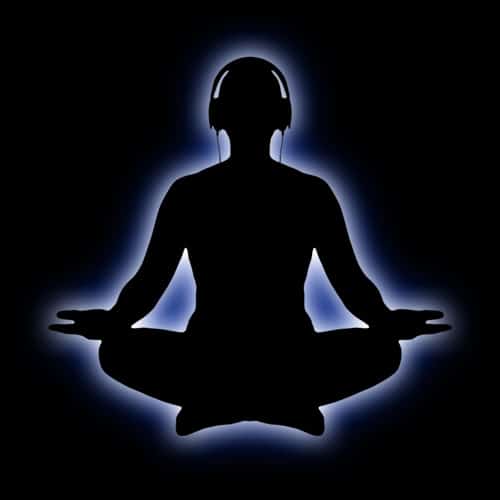There are hundreds, maybe thousands of meditation techniques, all with roughly the same intention: peacefulness, happiness, calmness, less pain, increased wisdom and compassion, and spiritual connection.
 There are seated meditations, walking meditations, standing meditations, and sleeping meditations. There are meditations that use the breath, a mantra, an image, a sound, fasting, psychedelic plants, isolation, and group retreats to name a few. Certain meditation techniques are used for specific situations or problems.
There are seated meditations, walking meditations, standing meditations, and sleeping meditations. There are meditations that use the breath, a mantra, an image, a sound, fasting, psychedelic plants, isolation, and group retreats to name a few. Certain meditation techniques are used for specific situations or problems.
We know from two thousand years of meditation history that there is one common thread among the eastern schools of meditation, actually two threads that are woven together. These two components are important to understand and develop. One is focused attention and the other is insight.
1. Focused Attention
This can also be understood as mindfulness, consciousness, focus, and concentration. We work with the quality of the focus and it’s consistency.
For example, focusing the mind on the inhalation and exhalation is basic to most meditation practices. Some meditation practices focus on a mantra or a candle flame. But all with the purpose of developing our ability to hold our attention and not be so scattered by thoughts and feelings. It provides an opportunity to rest the mind for longer periods of time.
2. In-sight 
This is the ability to see what is happening inside of us and navigate the ever changing experiences.
For example, as I focus my attention on my breathing for awhile, I calm down enough to have some insight about what I am feeling and thinking and then what to do about all that. If I cannot calm down a little, it is difficult to have a clear objective reflection about what is happening to me or what I need to do.
These two practices of attention and insight can then go back and forth.
As I calm from focused attention, there is insight and experience of what is happening in my mind and body. At this point, there is a tendency for feelings and thoughts to become overwhelming or underwhelming creating boredom and sleep. Going back to focus on the breath and the sensations of the body helps us to get grounded again so as to open up another calm space of accepting experiences and insights about the present moment. These can feel pleasant and unpleasant.
If the mind is racing there is always something that is not being felt. “What do I not want to feel?” Answer this question and feel that uncomfortable place. Try your best not to ruminate on it, but feel it in the heart or the gut. Stay with the feeling and the racing thoughts will slow down and the awareness of the breath will return.
These opposites begin to work together as we go back and forth between focus and insight, chaos and peace, thought and no-thought. Gradually we begin to have two legs to stand on. We can not only feel what we feel but stay embodied when feeling it.
We are then beginning to practice an inner art of regulating our attention from one pointedness to a relaxed openness to whatever arises; such as, feeling, sensation, image, felt vision and so forth. It can be seen as a strengthening or development of wisdom. This is a wisdom of self awareness.
3. Relax a little 
This is just being with whatever arises. Now the attention is shifting to include not just the body, breath and mind but the world around us. We are relaxing into the inner world and the external world as it is. We begin navigating the internal world at this point by relaxing a little bit at a time. By relaxing into the pleasant and unpleasant feelings, memories, sensations, images and so forth, we are able to stay grounded and yet wide open.
As we attempt to not judge the experiences and not be overwhelmed by them, we can get a sense of their felt nature, their demeanor. Just as we would get to know someone in our external life. Each person has a different feeling at different times.
We need to focus our attention to listen to others, as well as listening to ourselves with the same nonjudgmental curiosity. Then as we stay focused for a period of time there is a natural sensation to relax and open to the unknown.
The problem of too much thinking
One of the biggest misconceptions toward thinking is that “I create my own thoughts and feelings”, yes and no. Meditation separates the thoughts and feelings that are beyond my control from the thoughts and feelings that are in my control. That is the benefit of self awareness. It is an art of distinguishing the Way.
For example, I can begin a meditation by keeping my attention on incoming breath, outgoing breath, and the experience of the sensations throughout my entire body, trying to stay with the feeling of the breath and body for longer periods of time between spacing out.
As I stay with the feeling of breath and body; thoughts, feelings, memories and so forth will naturally disturb this attention. I then notice where the mind went and with as little judgement as possible bring it back to body and breath. 
Thoughts and feelings come out of the unconscious, in spite of how much we try to repress them; such as, a worry. “I” can then begin to develop an exhausting story about this worry rather than just feeling the anxiety.
When I realize I am involved in a story in my head, I wake up at sometime and remember, “Breath and Body”. It is like waking up from a dream, it’s a day dream.
I then disconnect my attention from the developing story and return it to the breath and body. It is a place to return to, a feeling of home base and rootedness.
As we detach from the story a little, the mind slows a little. We can be a little more ready for the next wave of feeling or the next bubble of memory to arise from within. We then feel it, have the memory and allow it to flow on through with out adding too much thought or resistance.
When there is a calming through this gentle focused attention on breath and body the mind can relax and be ready for the next unexpected experience arising out of the unconscious.
This attention is commonly called mindfulness; mindfulness of breath, mindfulness of mind, mindfulness of sensation, sound, texture and so forth.
In-sight meditation is a broader awareness. Just to feel the subtleties of mind and body keeps them from splitting into two, splitting head and heart for example. This is a navigation of the inner life. There is no need to get away from the various feeling states, memories, fantasies, and discursive talking to oneself. Meditation is not a method to avoid hurt, fear, sadness and so forth. But a method to see what is there, experience it and then suffer it if need be. Then, there is a greater chance for a genuine connection to ourselves, others and the greater mystery.
Meditation therapy 
As a psycho therapist, I usually recommend meditation for those with invasive anxiety. This becomes a therapeutic meditation for calming the anxiety enough to have some insight into what the anxiety is pointing to that is outside of conscious awareness. It is unconscious.
This is meditation therapy because I am able to help bring these feelings into consciousness. Feelings that are painful and confusing. Therapeutic meditation then becomes a method of handling deeper issues without getting overwhelmed.
This is an example of where meditation and psychotherapy can come together. One of the biggest problems that westerners have with meditation is how to bring personal problems and relationship issues into meditation. Often meditators are trying to meditate away their personal and relational problems, rather than using them as a path of awakening to a broader personality.
Meditation techniques for beginners
Sometimes beginners have a difficult time focusing on the breath and body. They might need a guided audio meditation to begin with and then gradually add on short periods of sitting with the breath and body.
Some people find counting the breath one to ten helps with focus. Others add a word or phrase with the breath, sometimes called a mantra. Some people begin with Transcendental Meditation techniques which use a mantra as the main focus.
The following is a seven minute meditation:
Relaxation technique , mp3 
